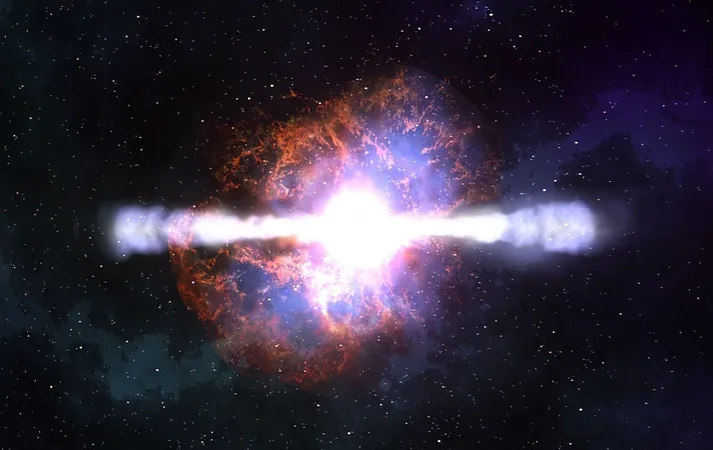
How Nearby Supernovae Shaped Life on Earth: The Cosmic Connection You Never Knew About!
2024-09-24
The Significance of Supernovae in Cosmic Evolution
When a giant star meets its explosive end in a supernova, it does far more than simply light up the universe with an awe-inspiring display. These cosmic events play a crucial role in the formation of heavy elements, including iron, which are blasted into space during the explosion. Recent studies have uncovered two significant deposits of the iron isotope Fe60 found in sea-floor sediments that date back to two to three million years ago, and another accumulation that is about five to six million years old.
The Impact of Cosmic Radiation on Evolution
More than just creating elements, these supernova explosions exposed Earth to heightened levels of cosmic radiation, raising intriguing questions about their impact on the evolution of life. A groundbreaking research paper titled “Life in the Bubble: How a nearby supernova left ephemeral footprints on the cosmic-ray spectrum and indelible imprints on life,” authored by Caitlyn Nojiri and her team from UC Santa Cruz, dives into this cosmic mystery.
Radiation's Role in the Evolutionary Process
“Life on Earth is evolving under the continuous barrage of ionizing radiation from both terrestrial sources and cosmic phenomena,” the authors note. While terrestrial radiation slowly declines over time, the exposure to cosmic radiation varies as our Solar System journeys through the galaxy. Nearby supernova explosions can drastically increase radiation levels on Earth, potentially influencing evolutionary processes.
Tracing Fe60 Back to Cosmic Events
The researchers trace the younger accumulation of Fe60 directly to a supernova explosion, while the older accumulation aligns with a unique cosmic event: Earth's passage into the Local Bubble, a vast region filled with hot gas formed by the stellar winds of massive OB stars. This bubble, nearly 1,000 light-years wide, is a remnant of past supernovae, with 15 such events over the last 15 million years leading to its formation.
The Link Between Supernovae and Species Diversification
The intriguing connection between these cosmic events and life on Earth prompts further inquiry. The radiation emitted from supernovae may cause DNA double-strand breaks—serious damage known to lead to mutations and contribute to the diversification of species. A recent study hinted that virus diversification in Africa's Tanganyika Lake accelerated around the same period as the Fe60 deposits; could supernova radiation be at play?
Cosmic Radiation: A Double-Edged Sword?
While the radiation may not have been strong enough to trigger catastrophic extinction events, it seems plausible that it facilitated mutations, catalyzing species diversification instead. However, researchers emphasize the importance of contextualizing radiation as a constant environmental factor that fluctuates over time as Earth moves through the galaxy.
Questions for Future Research
The lingering question remains: At what point does increased radiation become either a boon or a bane for biological evolution? “To fully grasp the influence of cosmic radiation on Earth’s biota, we need to better understand the biological effects of radiation, particularly from muons, which are predominant at ground level but remain inadequately studied,” Nojiri and her colleagues assert.
A Cosmic Connection to Our Existence
This research underscores a fascinating truth: our existence is intricately tied to cosmic phenomena, with supernova radiation potentially playing a pivotal role in the evolutionary saga of life on our planet. Imagine a world stripped of these cosmic interactions—life as we know it could have evolved very differently!
The Takeaway Message
In short, the study reveals a powerful message: while we may not see cosmic forces at work every day, they quietly shape our very existence. Supernovae may have impacted mutation rates at crucial junctures in Earth's history, helping guide evolution. Without these staggering cosmic explosions, Earth's biosphere could offer a wildly different tale; the threads of our evolution are interwoven with the fabric of the universe. The reality behind our existence could well hinge on ancient celestial events, proving that the universe truly does have a hand in shaping life on Earth!




 Brasil (PT)
Brasil (PT)
 Canada (EN)
Canada (EN)
 Chile (ES)
Chile (ES)
 España (ES)
España (ES)
 France (FR)
France (FR)
 Hong Kong (EN)
Hong Kong (EN)
 Italia (IT)
Italia (IT)
 日本 (JA)
日本 (JA)
 Magyarország (HU)
Magyarország (HU)
 Norge (NO)
Norge (NO)
 Polska (PL)
Polska (PL)
 Schweiz (DE)
Schweiz (DE)
 Singapore (EN)
Singapore (EN)
 Sverige (SV)
Sverige (SV)
 Suomi (FI)
Suomi (FI)
 Türkiye (TR)
Türkiye (TR)